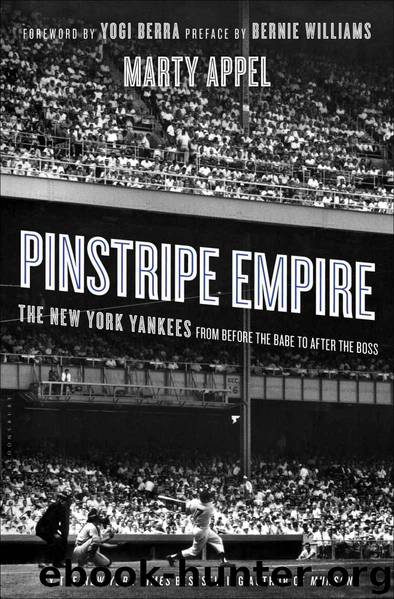Pinstripe Empire by Appel Marty

Author:Appel, Marty [Appel, Marty]
Language: eng
Format: epub
Publisher: Bloomsbury Publishing Plc
Published: 2012-05-08T00:00:00+00:00
DIMAGGIO WAITED UNTIL December 11 to make his plans public. Similar to what Ruth had done after his last Yankee season, he toured Japan and Korea with a traveling U.S. team. But when Red Patterson alerted the New York press to come to the team’s Fifth Avenue office in the middle of the Christmas shopping season, they knew this was the day that Joe would retire.
“I’ve played my last game of ball,” he said.
Joe never wanted to be embarrassed on the field, and hitting .263 with 12 homers on a painful heel was not a DiMaggio season to be proud of. His mother had died in June. The two scouts who had arranged for the Yankees to acquire him, Joe Devine and Bill Essick, had died twenty days apart in the fall. A magazine had published a scouting report on Joe that said he’d become very ordinary in some areas. He exited on his own terms, dignity intact. He probably wished he had quit a year earlier.
DiMaggio played only thirteen seasons, having lost three to the war. In ten of them, the Yanks played in the World Series. He hit .325 lifetime, but the rest of his lifetime stats reflected just thirteen years of play, not the long career he could have had. It didn’t matter to people who loved the game and knew perfection when they saw it. He would be the standard of on-field excellence for a generation.
The “retirement” of a player was rare; most got released when it was time to go. Before the breakdown of baseball’s Reserve Clause in 1976, a retirement created the oddity of a player still bound for life to a team. Had DiMaggio chosen, say, to come back at age forty-four seven years later as a pinch hitter for the San Francisco Giants, he would have found that the Yankees still controlled him. Over the years, the Yankees’ list of “retired players” was small, but technically they held lifetime control over anyone who left that way—like Reynolds, Brown, Coleman, McDougald, Collins, Kubek, Richardson, and Mantle, plus a few lesser names.
DiMaggio would replace Dizzy Dean on Yankee pregame telecasts, looking awkward in the process, and in 1954 would marry Marilyn Monroe for 274 days, sealing his place in American history as not just a baseball star but as an iconic figure in American culture. Ernest Hemingway would write about him in The Old Man and the Sea. Gay Talese wrote a landmark piece about him for Esquire magazine. Paul Simon would use his five-syllable name in “Mrs. Robinson.” He attended all but one Old-Timers’ Day for the rest of his life, which lasted forty-eight more years. (After 1988, he ceased wearing a uniform at those gatherings; he took his last at-bat in 1975.) His Yankee association always trumped any other commitment; he loved the connection and still loved hearing the roar of the crowd. Though some believed he could be difficult, he understood his place in American lore, and when all was said and done, there was only one Joe DiMaggio.
Download
This site does not store any files on its server. We only index and link to content provided by other sites. Please contact the content providers to delete copyright contents if any and email us, we'll remove relevant links or contents immediately.
| African Americans | Civil War |
| Colonial Period | Immigrants |
| Revolution & Founding | State & Local |
Cat's cradle by Kurt Vonnegut(14763)
Pimp by Iceberg Slim(13781)
Underground: A Human History of the Worlds Beneath Our Feet by Will Hunt(11840)
4 3 2 1: A Novel by Paul Auster(11794)
The Radium Girls by Kate Moore(11624)
Wiseguy by Nicholas Pileggi(5320)
American History Stories, Volume III (Yesterday's Classics) by Pratt Mara L(5138)
Perfect Rhythm by Jae(5074)
The Fire Next Time by James Baldwin(5021)
Paper Towns by Green John(4803)
Pale Blue Dot by Carl Sagan(4620)
A Higher Loyalty: Truth, Lies, and Leadership by James Comey(4554)
The Mayflower and the Pilgrims' New World by Nathaniel Philbrick(4283)
The Doomsday Machine by Daniel Ellsberg(4248)
Killers of the Flower Moon: The Osage Murders and the Birth of the FBI by David Grann(4191)
Too Much and Not the Mood by Durga Chew-Bose(4096)
The Sympathizer by Viet Thanh Nguyen(4096)
The Borden Murders by Sarah Miller(4021)
Sticky Fingers by Joe Hagan(3913)
